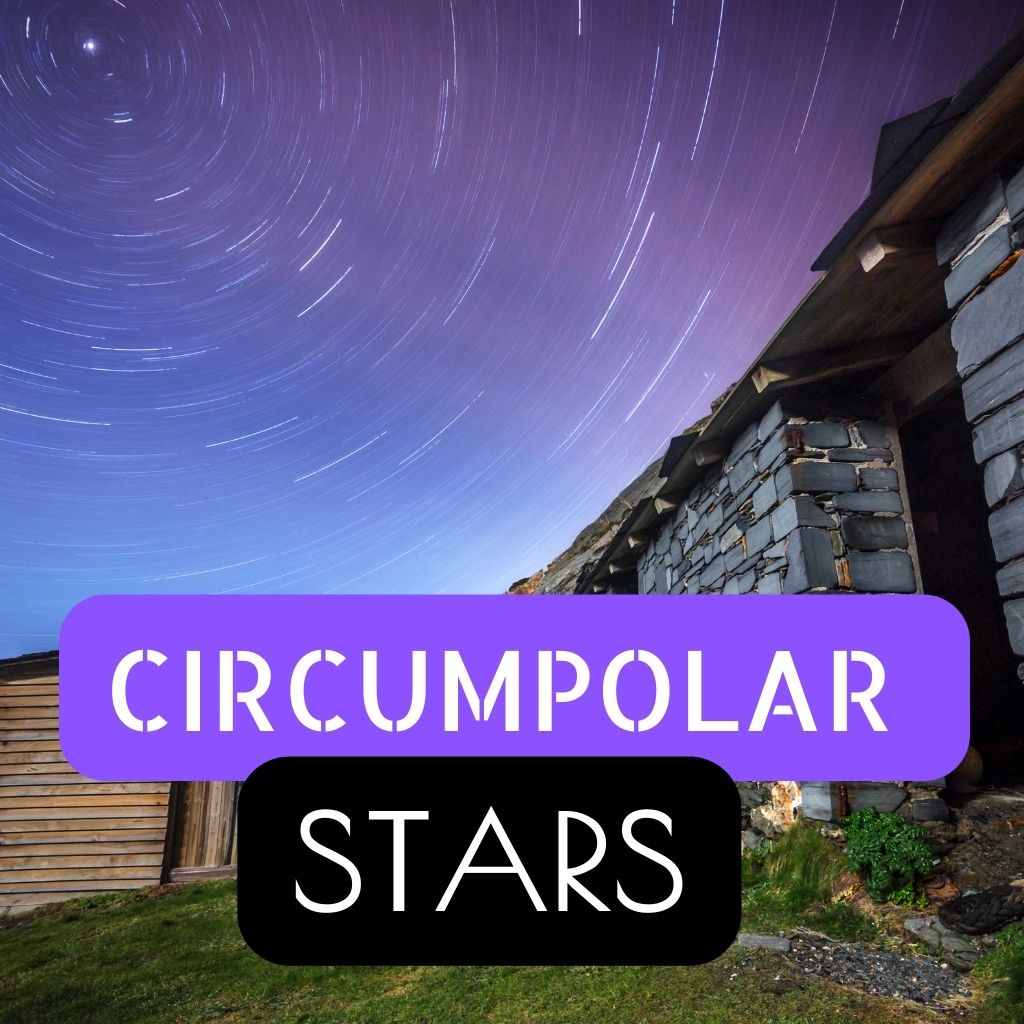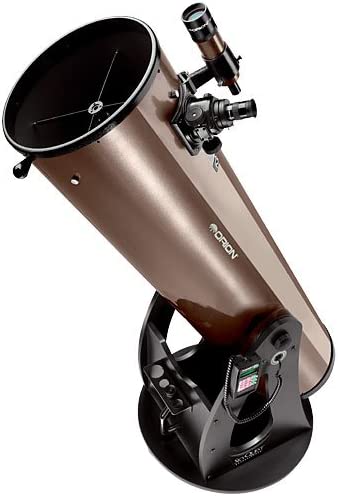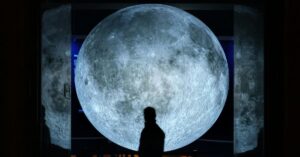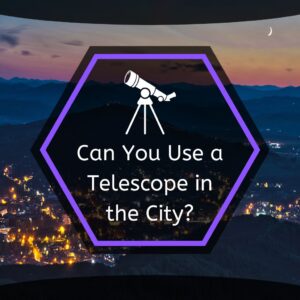This site contains affiliate links to products. I may receive a commission for purchases made through these links.
Stargazing has always been a fascinating activity for humans, and one of the most interesting objects to observe in the night sky are the circumpolar stars.
These celestial gems are visible throughout the year from specific locations on Earth, and their constancy and reliability have made them valuable tools for navigation and timekeeping throughout history.
However, finding and identifying these stars can be challenging, especially for beginners.
In this article, we will explain how to locate and identify them and explore some of the most prominent examples of these beautiful and fascinating objects in the sky.
What are circumpolar stars?
Circumpolar stars are stars that appear to move around the celestial poles without ever setting below the horizon. They remain visible in the sky throughout the night, every night, all year long.
These stars are located close to the North or South celestial poles and are visible only in the respective hemisphere. The term “circumpolar” is derived from the Latin words “circum,” meaning “around,” and “polaris,” meaning “pole.”
The circumpolar regions of the sky contain some of the brightest stars visible from Earth.
Circumpolar stars in Chinese astronomy
Circumpolar stars have been used for navigation and timekeeping in many cultures throughout history, including in Chinese astronomy. They were used to determine the position of the celestial pole and the time of day.
One famous Chinese astronomer, Guo Shoujing, developed a method for accurately measuring the position of the celestial pole using observations of circumpolar stars.
This method was used to construct a large astronomical instrument known as the Yuanxiang Observatory, which was completed in the 14th century.
Circumpolar stars were also used in Chinese astrology, where they were associated with certain animals and elements. For example, the circumpolar star Polaris was associated with the element water and the animal turtle.
Circumpolar stars in modern times
Today, circumpolar stars are still used for navigation, timekeeping, and astronomical research. They are also a popular subject for stargazers and amateur astronomers, who enjoy the challenge of identifying and observing these elusive stars.
In addition, circumpolar stars have been used by scientists to study the Earth’s rotation and the motion of the stars themselves.
Scientists can learn more about the structure and dynamics of the Milky Way galaxy and the universe as a whole by tracking the positions of circumpolar stars over time.
How do I know what stars are circumpolar?
To determine which stars are circumpolar, you need to know your latitude. Circumpolar stars are stars that never dip below the horizon as viewed from a particular location on Earth.
For observers located at latitudes between the equator and the North Pole, circumpolar stars are those located within a certain distance from the celestial North Pole.
The easiest way to identify circumpolar stars is to use a star chart or planetarium software that allows you to adjust for your location and time of year.
You can also look for constellations that are always visible in the northern sky, such as Ursa Major and Cassiopeia.
Where are circumpolar stars located?
Circumpolar stars are located near the celestial poles, which are the points in the sky directly above the Earth’s North and South Poles.
In the Northern Hemisphere, circumpolar stars can be found around the North celestial pole, while in the Southern Hemisphere, they can be found around the South celestial pole.
When can circumpolar stars be seen?
Circumpolar stars can be seen every night of the year, as they never dip below the horizon. However, the visibility of circumpolar stars can be affected by factors such as light pollution, weather conditions, and the viewer’s latitude.
A telescope can provide a more detailed and magnified view of these stars than what you can see with the naked eye.
Celestron NexStar 6SE Telescope is a great option for beginners and intermediate-level astronomers. It has a 6-inch aperture and is equipped with Celestron’s signature NexStar computerized mount, which can automatically locate and track celestial objects, including circumpolar stars.
This telescope is also portable and easy to set up, making it ideal for stargazing on the go.
Orion SkyQuest XT10 Classic Dobsonian Telescope is a larger, more advanced option for serious stargazers. It has a 12-inch aperture and a simple yet sturdy Dobsonian mount, which is easy to use and provides stable views of celestial objects.
With its large aperture, this telescope can provide clear, detailed views of circumpolar stars and other celestial objects, even in light-polluted areas.
You may also like: 10 Best Dobsonian Telescopes (Ranked!)
Circumpolar stars in the Northern Hemisphere
Throughout the year, five constellations located in the northern hemisphere can be observed from most locations north of the equator.
They are
- Ursa Major (Great Bear)
- Cassiopeia (Queen)
- Draco (Dragon)
- Cepheus (King)
- Camelopardalis (Giraffe)
Circumpolar stars in the Southern Hemisphere
In the Southern Hemisphere, circumpolar stars can be found around the South celestial pole.
The most famous circumpolar constellation is the Southern Cross, which contains four bright stars arranged in the shape of a cross.
The Southern Cross is an important symbol in many cultures and is prominently featured on the flags of several countries in the Southern Hemisphere.
Other examples of circumpolar stars in the Southern Hemisphere include
- Centaurus
- Carina
- Grus
- Lupus
- Cruz
- Eridanus
- Hydrus
- Tucana
Brightest circumpolar stars
Ursa Major and Cassiopeia are two of the brightest and most recognizable circumpolar constellations in the night sky.
Ursa Major, also known as the Big Dipper or the Plough, is particularly well-known for its distinctive shape, while Cassiopeia is often referred to as the “W” or “M” constellation because of the zigzagging pattern of the bright star.
Do circumpolar stars move East to West?
Circumpolar stars appear to move in a circular path around the celestial poles. However, they do not move east to west like other stars. Instead, they appear to rotate counterclockwise around the celestial poles, completing one full circle in 24 hours. But they do not rise or set.
Why do circumpolar stars never set?
The reason why circumpolar stars never rise, nor set is that they are always above the observer’s horizon. The observer’s horizon moves as the Earth rotates, but the circumpolar stars remain above it, making them visible throughout the night.
The stars that are not circumpolar appear to rise in the east and set in the west due to the rotation of the Earth, but circumpolar stars remain fixed in the same position relative to the celestial pole, which makes them useful for navigation and timekeeping.
Why are there more circumpolar stars at the North Pole?
The reason why there are more circumpolar stars at the North Pole is that the North Pole is located at the Earth’s axis of rotation, which is also the celestial pole.
As a result, any star located within a certain distance from the celestial pole (which is determined by the observer’s latitude) will be circumpolar and never set below the horizon.
At the North Pole, the observer’s latitude is 90 degrees North, which means that any star within 90 degrees of the celestial pole (which is located directly above the North Pole) will be circumpolar and never set.
This includes all the stars in the northern hemisphere, which means that from the North Pole, every star in the sky stays above the horizon all day long, every day of the year.
In contrast, at lower latitudes, the distance between the observer and the celestial pole is greater, which means that fewer stars are circumpolar and more stars rise and set each night.
The circle of circumpolar stars in the sky is determined by the observer’s latitude, and it expands as you move farther north towards the North Pole.
How to calculate circumpolar stars declination
Declination is the angular distance of a celestial body north or south of the celestial equator. Circumpolar stars have a declination greater than the latitude of the viewer’s location.
In other words, if the viewer is located at a latitude of 40 degrees North, then any star with a declination greater than 40 degrees North will be circumpolar.
To calculate the declination of circumpolar stars, you can use the following formula:
Declination of Circumpolar Stars = 90° – Latitude of the Observer
For example, if you are located at a latitude of 40°N, the declination of circumpolar stars would be:
= 90° – 40° = 50°N
This means that all stars with a declination greater than 50°N are circumpolar from your location and never set below the horizon.
To calculate the declination of a circumpolar star, one can use an astronomical almanac or a star chart. Alternatively, there are several online resources that provide this information.
What is the max altitude of circumpolar stars?
The maximum altitude of a circumpolar star is equal to the altitude of the celestial pole above the horizon at the viewer’s latitude.
For example, at the North Pole, the altitude of the North celestial pole is 90 degrees, which means that all circumpolar stars are at their maximum altitude of 90 degrees above the horizon.
At the equator, however, the altitude of the celestial poles is 0 degrees, which means that no circumpolar stars are visible.
Are there less circumpolar stars at the equator?
At the Earth’s equator, no star is circumpolar because of the way the Earth rotates on its axis. The rotation causes all the stars to appear to move across the sky, rising in the east and setting in the west.
As a result, stars that are circumpolar at the North or South Pole are not visible from the equator.
Conversely, stars that are always visible at the equator are not circumpolar from the poles. This difference in visibility is due to the curvature of the Earth’s surface and its orientation with respect to the stars.
Circumpolar star identification techniques
There are several techniques that can be used to identify circumpolar stars, depending on the viewer’s location and familiarity with the night sky.
Identification of Circumpolar stars in the Northern Hemisphere
In the Northern Hemisphere, circumpolar stars can be identified using the following techniques
Find Polaris
Polaris, also known as the pole star, is the most famous circumpolar star and can be easily located using the constellation Ursa Major (the Big Dipper). The two stars at the end of the Big Dipper’s bowl point towards Polaris, which is located in the constellation Ursa Minor (the Little Dipper).
Use the North Star as a reference point
Once Polaris has been identified, it can be used as a reference point to locate other circumpolar stars in the northern celestial hemisphere.
Look for Cassiopeia
Cassiopeia is another constellation that contains several bright circumpolar stars. It is shaped like a “W” and is located opposite Ursa Major and Polaris. Cassiopeia is visible year-round in the northern hemisphere and is useful for locating other constellations and stars in the region.
Use a star finder
A star finder is a useful tool for identifying circumpolar stars, especially for beginners. Star finders show the location of stars and constellations in the sky and can be customized for different times of the year and latitudes. The Night Sky Star Finder is suitable for your needs.
Identifying the circumpolar stars in the Southern Hemisphere
In the Southern Hemisphere, circumpolar stars can be identified using the following techniques:
Find the Southern Cross
The Southern Cross is a constellation that contains several bright circumpolar stars and is easily recognizable in the Southern sky. It is located close to the South celestial pole and is visible year-round in the southern hemisphere.
Use the South celestial pole as a reference point
Similar to Polaris in the northern hemisphere, the South celestial pole remains stationary in the sky and can be used as a reference point to locate other circumpolar stars in the southern celestial hemisphere.
Look for the Magellanic Clouds
The Magellanic Clouds are two small galaxies visible in the southern sky and contain several bright circumpolar stars. They are located close to the South celestial pole and can be used as a guide to locate other stars and constellations in the region.
Use a star finder
As with the northern hemisphere, a star finder is a useful tool for identifying circumpolar stars in the southern hemisphere.
FAQs about circumpolar stars
Here are some frequently asked questions about circumpolar stars:
What are circumpolar stars in Chinese astronomy?
In Chinese astronomy, circumpolar stars are known as “north circumpolar stars” and “south circumpolar stars.” They are used in conjunction with the 28 Chinese lunar mansions to determine the positions of celestial objects.
Does Kenya see circumpolar stars?
Circumpolar stars cannot be seen from Kenya or any other location near the equator. This is because the celestial poles are located near the Earth’s poles, and the closer you are to the equator, the lower the altitude of the celestial poles.
Can I see circumpolar stars in California?
Circumpolar stars can be seen from California and any other location at latitudes north of about 35 degrees north. However, the number of circumpolar stars visible will depend on your latitude and the time of year.
Can I see circumpolar stars from the US?
As the United States is located at a mid-latitude range, it is far from both the North and South poles, so you cannot see all circumpolar stars in the sky from your home. However, Polaris, also known as the North Star, is the brightest and most famous circumpolar star that can be seen from most parts of the United States.
Other circumpolar stars, such as those located near the South Celestial Pole, such as Acrux, are not visible from most spots in the US but may appear to those who live in the southernmost parts of the country, such as southern Florida, southern Arizona, and southern California.
What celestial objects are considered circumpolar?
In addition to stars, any celestial object located near the celestial poles can be considered circumpolar. This includes the Sun, Moon, planets, and some deep-sky objects such as galaxies and nebulae.
What are the 5 circumpolar constellations?
The five circumpolar constellations visible from most northern latitudes are Ursa Minor (the Little Dipper), Ursa Major, the Great Bear Draco (the Dragon), Cepheus (the King), and Cassiopeia (the Queen.
What are circumpolar Messier objects?
Circumpolar Messier objects are deep-sky objects that are located near the celestial poles and are visible all year round from northern latitudes. Some examples include the Pleiades star cluster (Messier 45), the Andromeda Galaxy (Messier 31), and the Whirlpool Galaxy (Messier 51).
Takeaway: Enjoy your stargazing experience by identifying all the stars
Circumpolar stars are a fascinating celestial phenomenon that has captured the attention and imagination of humans for thousands of years.
These stars appear to revolve around the celestial poles without ever setting, providing a reliable reference point for navigation and timekeeping.
Circumpolar stars can be observed from locations at high latitudes, and their visibility and number depend on the observer’s latitude and the time of year.
Observing circumpolar stars can be a rewarding and enlightening experience. So next time you gaze up at the stars, take a moment to appreciate the beauty and wonder of these steadfast celestial companions.
You may also like:








